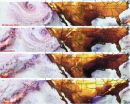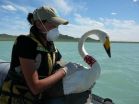(Press-News.org) The Tropical Rainfall Measuring Mission or TRMM satellite provided a look at the rainfall associated with the large storm system that brought soaking rains to California on Feb. 28 and Mar. 1. Satellite imagery created at NASA shows the movement of the storm from the U.S. West Coast to the East Coast.
At NASA's Goddard Space Flight Center in Greenbelt, Md. images were created using data from the TRMM Microwave Imager (TMI) instrument that showed the movement of recent stormy weather from California's Pacific Ocean coast to the Atlantic Coast. TRMM is a satellite managed by both NASA and the Japan Aerospace Exploration Agency known as JAXA. Both agencies recently launched the GPM observatory, the follow-up to TRMM.
TRMM Images are routinely produced using TMI data which show the global area covered by the satellite. "Those 'quick look' images use microwave brightness temperatures at 85.5 GHZ and at 37.0 GHZ combined in the red, green and blue components of the images," said Hal Pierce of the NASA TRMM team at Goddard who produced the images. "The false color images can be used to distinguish land from water and show the differences between land surfaces such as deserts, snow cover and sea ice. On these images areas of dry atmosphere over water appear as blue and moist atmosphere is dark blue. Snow cover over land appears as white or grey, deserts are green. Scattering (by cloud ice) is shown as yellow."
VIDEO:
This animation from Feb. 28 to Mar. 3 shows the movement of the rain associated with the storm system that soaked California. On Mar. 3, precipitation (yellow) and snow cover...
Click here for more information.
The images Pierce created show TRMM Microwave Imager (TMI) views of the movement of the recent stormy weather from California's Pacific Ocean coast to the Atlantic Coast. The first TRMM TMI image from February 28 showed a large low pressure center in the Pacific Ocean moving toward California. Rain associated with this storm dropped over four inches of rain in Los Angeles that resulted in evacuation orders.
The next day, March 1, the center of the storm was just off the California coast and precipitation had also moved into Arizona. By Sunday, March 2, precipitation in the form of rain, freezing rain and snow extended from New Mexico through the Ohio valley. On Monday, March 3, TRMM's TMI instrument showed precipitation (yellow) and snow cover (white/yellow) over large areas of the eastern United States.
INFORMATION:
Harold F. Pierce
SSAI/NASA Goddard Space Flight Center
NASA's TRMM satellite images show California soaker moved eastward
2014-03-06
ELSE PRESS RELEASES FROM THIS DATE:
NASA's THEMIS discovers new process that protects Earth from space weather
2014-03-06
In the giant system that connects Earth to the sun, one key event happens over and over: solar material streams toward Earth and the giant magnetic bubble around Earth, the magnetosphere helps keep it at bay. The parameters, however, change: The particles streaming in could be from the constant solar wind, or perhaps from a giant cloud erupting off the sun called a coronal mass ejection, or CME. Sometimes the configuration is such that the magnetosphere blocks almost all the material, other times the connection is long and strong, allowing much material in. Understanding ...
Crystals ripple in response to light
2014-03-06
Light can trigger coordinated, wavelike motions of atoms in atom-thin layers of crystal, scientists have shown. The waves, called phonon polaritons, are far shorter than light waves and can be "tuned" to particular frequencies and amplitudes by varying the number of layers of crystal, they report in the early online edition of Science March 7.
These properties - observed in this class of material for the first time - open the possibility of using polaritons to convey information in tight spaces, create images at far finer resolution than is possible with light, and manage ...
Plasma plumes help shield Earth from damaging solar storms
2014-03-06
The Earth's magnetic field, or magnetosphere, stretches from the planet's core out into space, where it meets the solar wind, a stream of charged particles emitted by the sun. For the most part, the magnetosphere acts as a shield to protect the Earth from this high-energy solar activity.
But when this field comes into contact with the sun's magnetic field — a process called "magnetic reconnection" — powerful electrical currents from the sun can stream into Earth's atmosphere, whipping up geomagnetic storms and space weather phenomena that can affect high-altitude aircraft, ...
Researchers calculate how river networks move across a landscape
2014-03-06
Large river networks — such as those that funnel into the Colorado and Mississippi rivers — may seem to be permanent features of a landscape. In fact, many rivers define political boundaries that have been in place for centuries.
But scientists have long suspected that river networks are not as static as they may appear, and have gathered geologic and biological evidence that suggest many rivers have been "rewired," shifting and moving across a landscape over millions of years.
Now researchers at MIT and the Swiss Federal Institute of Technology (ETH Zurich) have developed ...
Warmer temperatures push malaria to higher elevations
2014-03-06
Researchers have debated for more than two decades the likely impacts, if any, of global warming on the worldwide incidence of malaria, a mosquito-borne disease that infects more than 300 million people each year.
Now, researchers from the London School of Hygiene & Tropical Medicine and the University of Michigan, with colleagues, are reporting the first hard evidence that malaria does—as had long been predicted—creep to higher elevations during warmer years and back down to lower altitudes when temperatures cool.
The study, due to be published in Science and based ...
Scientists create detailed picture of protein linked to learning, pain and brain disorders
2014-03-06
LA JOLLA, CA, and NASHVILLE, TN – March 6, 2014 – Researchers at The Scripps Research Institute (TSRI) and Vanderbilt University have created the most detailed 3-D picture yet of a membrane protein that is linked to learning, memory, anxiety, pain and brain disorders such as schizophrenia, Parkinson's, Alzheimer's and autism.
"This receptor family is an exciting new target for future medicines for treatment of brain disorders," said P. Jeffrey Conn, PhD, Lee E. Limbird Professor of Pharmacology and director of the Vanderbilt Center for Neuroscience Drug Discovery, who ...
Warmer temperatures fuel spread of malaria into higher elevations
2014-03-06
In the tropical highlands of South America and East Africa, cool temperatures have historically kept mosquito-borne diseases, such as malaria, at bay. New research by Howard Hughes Medical Institute (HHMI) scientists shows that as annual temperatures rise in these areas, malaria can spread to populations in higher elevations that had historically not been at as much risk of being infected by malaria parasites.
HHMI scientists have compared the yearly distribution of malaria cases in two mountainous regions in South America and East Africa, and found that in warmer years, ...
Birds of all feathers and global flu diversity
2014-03-06
A group of international scientists have completed the first global inventory of flu strains in birds by reviewing more than 50 published studies and genetic data, providing new insight into the drivers of viral diversity and the emergence of disease that can ultimately impact human health and livelihoods.
The research, published in the journal PLOS ONE and performed as part of the USAID PREDICT project, identified over 116 avian flu strains in wild birds. This is roughly twice the number that were found in domestic birds, and more than ten times the number found in humans. ...
Returning vets face 'warring identities' distress
2014-03-06
PROVIDENCE, R.I. [Brown University] — Much of the research on post-combat mental health of veterans focuses on problems like post-traumatic stress disorder (PTSD) and major depression. A paper co-authored by R. Tyson Smith, visiting assistant professor of sociology, takes an even broader snapshot of returning soldiers' mental state by focusing instead on the identity conflict many face when transitioning from soldier to civilian life and how that conflict manifests as mental distress. The paper was published in the January issue of Society and Mental Health.
"You can't ...
Colored diamonds are a superconductor's best friend
2014-03-06
Flawed but colorful diamonds are among the most sensitive detectors of magnetic fields known today, allowing physicists to explore the minuscule magnetic fields in metals, exotic materials and even human tissue.
University of California, Berkeley, physicist Dmitry Budker and his colleagues at Ben-Gurion University of the Negev in Israel and UCLA have now shown that these diamond sensors can measure the tiny magnetic fields in high-temperature superconductors, providing a new tool to probe these much ballyhooed but poorly understood materials.
"Diamond sensors will give ...







